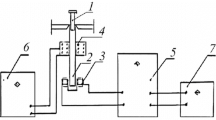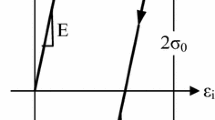Abstract
Fatigue crack paths for inclined cracks are studied through experiments and computations under different mixed-mode loading. The experimental study of fatigue crack growth in the aluminum and titanium alloys and two types of the steels is performed on compact tension shear specimens. The cyclic fracture process and damage zone concepts are introduced and used for numerical analysis of the crack tip fields. The elastic K1, K2 and plastic KP stress intensity factors are calculated by finite element method to characterize the fracture resistance along the curvilinear trajectories in compact tension shear specimens. The influence of mode-mixity and elastic-plastic material properties on the behavior of three crack tip regions as a function of cyclic loading is demonstrated.
Access provided by Autonomous University of Puebla. Download conference paper PDF
Similar content being viewed by others
Keywords
1 Introduction
To date, several of models have been presented in the literature for the purpose of analyzing the process of fatigue crack growth from the viewpoints of micromechanics, fracture and damage mechanics. Many fracture mechanics models are based on a critical distance local to the crack tip. It is considered a fundamental characteristic parameter that distinguishes damage at the microscopic and macroscopic scale levels. This characteristic distance is often identified with a fracture process zone or fracture damage zone. A general assumption regarding the distance criterion under elastic–plastic cyclic loading conditions is that a crack increment occurs when the fracture resistance parameter (stress, strain, or energy) reaches a critical value at a characteristic distance from the crack tip. It is well known that mixed-mode conditions appear when the direction of the applied loading does not coincide with the orthogonal KI-KII-KIII space. The main feature of the mixed-mode fracture is that the crack growth no longer takes place in a self-similar manner and does not follow a universal trajectory. Various fracture criteria and phenomenological approaches can predict the behavior of cracks in brittle and ductile materials loaded in combined modes. Even though many studies have been carried out in the literature to determine fracture characteristics of ductile materials under cyclic loading, it is important to investigate the local crack tip zones behavior due to low cycle fatigue for quasi-brittle and moderate ductile materials under mixed mode conditions.
2 Material Properties and Loading Conditions
Compact tension shear specimens (CTS, Fig. 1a) are made from P2M and 34X steels as well as aluminum Al7050 and titanium Ti-6Al-4 V alloys and used for cyclic mixed-mode fracture test with the loading direction variation from 90° (pure Mode I) to 0° (pure Mode II) with respect to the initial crack plane. Main static and low-cyclic mechanical properties of the tested materials are listed in Tables 1 and 2. The mixed-mode parameters expressed through the elastic and plastic stress intensity factors (SIFs) were varied by changing the load direction. Both Mode I and Mode II elastic SIFs K1 and K2 as well as general plastic SIF KP are evaluated along experimental crack path of each tested material based on the series of numerical calculations. On the CTS was realized the full range of mixed-mode cyclic fracture from tensile to shear loading. Figure 1b represents experimental fatigue crack growth trajectories with initial pure Mode II loading for tested steels, aluminum and titanium alloys.
Crack growth in the CTS specimen with the applied load angle β = 0° has its own characteristics. Initially, the deformation mode corresponds to the pure shear with ME = MP = 0. With an increase in the number of loading cycles N, the contribution of mixed modes of deformation and fracture gradually increases. As follows from Fig. 1, the crack path in an aluminum alloy Al7050 differs significantly from the experimental trajectories for other materials under the same loading conditions.
3 Plastic, Cyclic Fracture Process and Damage Zones Behavior
In front of a stable growing crack, we may distinguish three regions. The first outer contour represents the reversed plastic zone where the current values of stresses and deformations exceed the yield stress or strain of the material. The second region is fatigue fracture process zone. The third small area exists immediately ahead of the crack tip which is called the damage zone. For a strain-hardening material the elastic-plastic boundary around the crack tip can be obtained using the equivalent von Mises stress as a function of principal stress ratio λ = σ2/σ1
where for plane stress \( \eta_{i} = \sqrt {1 - \lambda + \lambda^{2} } \) and plane strain \( \eta_{i} = \sqrt {1 - \lambda + \lambda^{2} + \nu \left( {\nu - 1} \right)\left( {1 + \lambda } \right)^{2} } \).
Full-field 3D FE-analyses are carried out to determine stress-strain fields, elastic and plastic SIFs along the curvilinear crack path in the CTS subjected to different mixed mode loadings. Figure 2 shows that, for pure mode I (Fig. 2a) and pure mode II (Fig. 2b) the plastic zones have a symmetrical shape while for mixed mode (Fig. 2c) they is non-symmetrical with respect to the initial crack plane. The dimensions of the plastic zones in Fig. 2 for titanium alloy are satisfied to the conditions of small-scale yielding. Similar shapes of plasticity zones are observed for other tested materials.
The variable critical distance is one of important parameter in modern fracture mechanics, denoted to as the fracture process zone (FPZ) size. A general assumption regarding the distance criterion under elastic–plastic cyclic loading is that a crack increment occurs when the fracture resistance parameter (stress, strain, or energy) reaches a critical value at a characteristic distance from the crack tip. The following expression was proposed by Shlyannikov [1] for normalized fracture process zone size based on the nonlinear crack-tip stress field and the main low cycle fatigue material properties
where n′ is low cycle fatigue hardening exponent, \( \varepsilon^{\prime}_{f} \) and \( \sigma^{\prime}_{f} \) are the fatigue ductility and strength coefficients, respectively, a is the crack length, σu is the ultimate true tensile strength, σ0 is the yield stress, σn is the nominal stress, \( \tilde{\sigma }_{e} \left( \theta \right) \) is dimensionless equivalent stress angular function, In is the governing parameter of the nonlinear crack tip field [1], Nf is the number of cycles to failure, Y1 and Y2 are geometry dependent for SIF correction factors. The equivalent elastic stress intensity factor (SIF) for mixed mode fracture can be determined by using energy release rate criterion [2]
where, θ* is the crack deviation angle, w is the cracked body width. The most general criterion of mixed mode crack growth direction is obtained [3] on the basis of the limiting state theory under multiaxial loading.
During low-cycle fatigue, the accumulation and growth of damage occurs in the local fracture process zone that covers the crack tip. The size of the fracture process zone is typically regarded as a distance-dependent parameter that physically represents the increase in crack size during the basic cyclic fracture process. Figure 3 shows the dependence of the both size and shape of the fracture process zone, according to Eqs. (2–5), on the accumulated number of loading cycles for the pure mode (Fig. 3a), pure mode II (Fig. 3b) and mixed mode (Fig. 3c, d) loading. It can be clearly observed that the FPZ contour behavior is not constant-size and were dependent on the accumulated loading cycles, mode mixity and both the static and low-cycle fatigue material properties. Figure 3c presents the process of changing the FPZ in the 7050 aluminum alloy according to the stages of cyclic loading, which are accompanied by corresponding changes in the mixed modes of fracture. Figure 3d give a comparison of the dimensions of the mixed-mode fatigue fracture process zone in the CTS specimen for all tested materials having different crack paths at final the number of cycles of loading, N/Nf = 1, as shown in Fig. 1b. Initially, owing to the same pure mode II plastic deformation in the crack tip region in several first cycles, the size of the low-cycle fatigue fracture process zone due to mode mixities is changed in different degree as a function of the tested material main mechanical properties.
A fatigue damage evolution equation was proposed by the authors [4] through connecting the damage variable with the static toughness exhausting during cyclic loading. This equation has the following form
where ωN−1 denotes the critical value of the damage variable, that is expressed by
An amplitude of cyclic stress at the crack tip can be determined by applying the singular HRR-type stress field
where KP is the plastic stress intensity factor and rc is the critical distance. The damage variable ωN indicate in Eq. (6) the measure of fatigue damage with ωN = 0 denoting the undamaged state and ωn = 1 the fully damaged state.
Figure 4 presents a comparison of the predicted values of the fatigue fracture damage evolution for pure mode I (Fig. 4a) and mixed modes (Fig. 4b) according to Eqs. (6–8) for all considered structural metallic materials. It may be seen that the mode mixity changed significantly the processes of fatigue damage accumulation only in the range N/Nf < 0.5.
In this work, an expression for the low cycle fatigue fracture process is derived; this includes static and cyclic material properties, as well as mixed mode fracture parameters. The elastic–plastic crack tip singularity fields are employed. The main finding, based on the numerical and experimental results, is that the effect of mixed mode fracture during low-cycle fatigue crack growth in considered steels, aluminum and titanium alloys leads to the conclusion that under pure mode I, pure mode II and mixed mode loading conditions and shape and size of the plastic, fracture process and damage zones do not coincide with each other and have a hierarchical structure.
References
Shlyannikov, V.N.: Creep–fatigue crack growth rate prediction based on fracture damage zone models. Eng. Fract. Mech. 214, 449–463 (2019)
Citarella, R., Cricri, G.: Comparison of DBEM and FEM crack path predictions in a notched shaft under torsion. Eng. Fract. Mech. 77, 1730–1749 (2010)
Shlyannikov, V.N.: Mixed-mode static and fatigue crack growth in central notched and compact tension shear specimens. ASTM STP 1359, 279–294 (1999)
Duyi, Y., Zhenlin, W.: A new approach to low-cycle fatigue damage based on exhaustion of static toughness and dissipation of cyclic plastic strain energy during fatigue. Int. J. Fatigue 23, 679–687 (2001)
Author information
Authors and Affiliations
Corresponding author
Editor information
Editors and Affiliations
Rights and permissions
Copyright information
© 2020 Springer Nature Switzerland AG
About this paper
Cite this paper
Shlyannikov, V., Fedotova, D. (2020). Crack Growth and Plastic, Fracture Process and Damage Zones Behavior Under Mixed Mode Loading. In: Gdoutos, E., Konsta-Gdoutos, M. (eds) Proceedings of the Third International Conference on Theoretical, Applied and Experimental Mechanics. ICTAEM 2020. Structural Integrity, vol 16. Springer, Cham. https://doi.org/10.1007/978-3-030-47883-4_21
Download citation
DOI: https://doi.org/10.1007/978-3-030-47883-4_21
Published:
Publisher Name: Springer, Cham
Print ISBN: 978-3-030-47882-7
Online ISBN: 978-3-030-47883-4
eBook Packages: EngineeringEngineering (R0)








